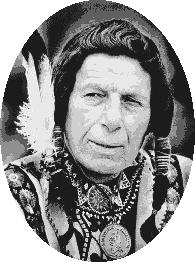Claim: The actor known as Iron Eyes Cody was a true-born Native Indian.
Origins: Although no one could say exactly when we humans first began to have concerns about the effects our activities have on our environment, most of us baby boomers could pinpoint

timespan during which we first became aware of the "ecology movement," as the era when concern for what humans were doing to the world they lived in ran at a fever pitch. Protecting the planet's resources by calling upon each person to pitch in and do whatever he or she could do to limit the abuse was seen as the right and proper focus of the times. High schools offered classes in ecology. Public school students painted posters decrying pollution. And television ads worked to remind everyone that the problem was real, here, and now.
Three events which occurred during the year between March 1970 and March 1971 helped bring the concept of "ecology" into millions of homes and made it a catchword of the era. One was the first annual Earth Day, observed on
In that enduring minute-long TV spot, viewers watched an Indian paddle his canoe up a polluted and flotsam-filled river, stream past belching smokestacks, come ashore at a litter-strewn river bank, and walk to the edge of a highway, where the occupant of a passing automobile thoughtlessly tossed a bag of trash out the car window to burst open at the astonished visitor's feet. When the camera moved upwards for a
That "crying Indian," as he would later sometimes be referred to, was Iron Eyes Cody, an actor who throughout his life claimed to be of Cherokee/Cree extraction. Yet his asserted ancestry was just as artificial as the tear that rolled down his cheek in that television spot
(The spurious use of Native Americans to promote "save the Earth" messages was not limited to this one instance. A moving exposition on the sanctity of the land and the need for careful stewardship of it is still widely quoted as the bona fide words of Chief Seattle. Though the chief was real, the speech was not — the words came not from the chief's own lips in 1854 but flowed from the pen of a screenwriter in 1971.)
Iron Eyes Cody was born Espera DeCorti on
children, with Espera (or Oscar, as he was called) their second eldest. In 1909, when Espera was five years old, Antonio DeCorti abandoned his wife and children and headed for Texas. Francesca married again, this time to a man named Alton Abshire, with whom she bore five more children.
As teenagers the three DeCorti boys joined their father in Texas. He had since altered his name from Antonio DeCorti to Tony Corti, and the boys apparently followed suit as far as their surname was concerned. In 1924, following their father's death, the boys moved to Hollywood, changed "Corti" to "Cody," and began working in the motion picture industry. It was about this time Iron Eyes began presenting himself to the world as an Indian. Iron Eyes' two brothers, Joseph William and Frank Henry, found work as extras but soon drifted into other lines of work. Iron Eyes went on to achieve a full career as an actor, appearing in well over a hundred movies and dozens of television shows across the span of several decades.
Although Iron Eyes was not born an Indian, he lived his adult years as one. He pledged his life to Native American causes, married an Indian woman (Bertha Parker), adopted two Indian boys (Robert and Arthur), and seldom left home without his beaded moccasins, buckskin jacket and braided wig. His was not a short-lived masquerade nor one that was donned and doffed whenever expedient — he maintained his fiction throughout his life and steadfastly denied rumors that he was not an Indian, even after his half-sister surfaced to tell the story in 1996 and to provide pointers to the whereabouts of his birth certificate and other family documents.
Cody died on 5 January 1999 at the age of 94.
Iron Eyes Cody wasn't history's only faux Indian. Others also falsely claimed this mantle:
- Long Lance, the 1928 thrilling first-person account of Chief Buffalo Child Long Lance, was the work of Sylvester Long, an African-American who conned the literary world into believing he was a Cherokee, and then a Cree. While the ruse lasted, Buffalo Child Long Lance was a hit on the lecture circuit and one of the darlings of New York society. His spree ended when the truth about his background was exposed in 1930, and he killed himself with a shot to the head in 1931.
- Grey Owl, a noted Canadian naturalist and author, lived as an Indian and claimed to be half-Apache. Only after his death in 1939 did the world discover he was really an Englishman born Archibald Belaney.
- One of the most popular books on Indian life is Forrest Carter's The Education of Little Tree, the story of a boyhood spent with Cherokee grandparents. This "autobiography" was yet another fake, penned by Asa Carter, a white supremacist and Ku Klux Klan member.
Even if Iron Eyes was not a true-born Native American, he certainly did a lot of good on behalf of the Native American community, and they generally accepted him as one of them without caring about his true ancestry. In 1995, Hollywood's Native American community honored Iron Eyes for his longstanding contribution to Native American causes. Although he was no Indian, they pointed out, his charitable deeds were more important than his non-Indian heritage.
Barbara "going native" Mikkelson
Additional information:
| | "People Start Pollution, People Can Stop It" public service ad (Keep America Beautiful) |
Last updated: 9 August 2007
 Sources:
Sources:
